Ciao! Meet the Indian-Italians
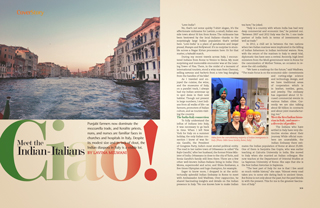
Punjabi farmers now dominate the mozzarella trade, and Keralite priests, nuns, and nurses are familiar faces in churches and hospitals in Italy. Despite its modest size and its lack of clout, the Indian diaspora in Italy is a visible lot.
‘Love-India’!
No, that’s not some quirky T-shirt slogan, it’s the affectionate nickname for Lavinio, a small, Italian seaside town about 50 km from Rome. The nickname has been bestowed by the local Italians—thanks to the surprisingly large Indian population that’s settled here. ‘Love-India’ is a place of gurudwaras and langar prasad, bhangra and Bollywood. It’s no surprise to stumble across a Nagar Kirtan procession here. Or for that matter, a kabaddi match.
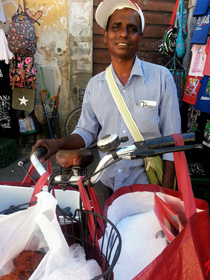
(Right) With a tote bag full of samosas and kachoris, a Tamil street vendor at the Leaning Tower of Pisa. (Photo: Lavina Melwani)
During my recent travels across Italy, I encountered Indians from Rome to Venice to Siena. My most surprising and memorable encounter was at the Leaning Tower of Pisa. There, in the midst of a tsunami of international tourists, stood a wiry man from Chennai, selling samosas and kachoris from a tote bag dangling from the handles of his bike!
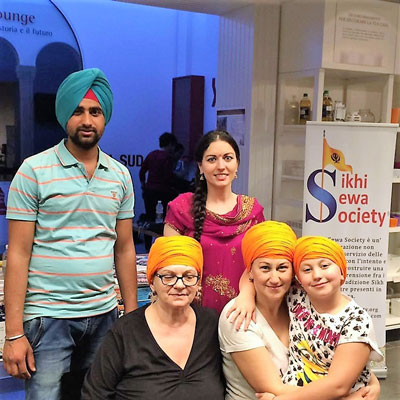
Sikhs (left) form the overwhelming majority of Indian immigrants in Italy. (Photo: Sikhi Sewa Society, Rome, Italy)
As I traveled and enjoyed the cuisine, the wine, and the museums of Italy, on a parallel track, I always had my Indian antennae up to spot desis in their new habitat. Though not present in large numbers, I met Indians from all walks of life—as farmers, promoters of Italian culture, and as tourists visiting the country.
The India-Italy connection
To fully understand the
influx of Indians into Italy,
it was necessary to go back
in time. When I left New
York for Italy on a summer
holiday, the only Italian connection
I knew of was Sonia
Gandhi, the President
of Congress Party, India’s most storied political entity.
The road in her native town of Orbassano is called ‘Via
Rajiv Gandhi,’ after her husband, the former Prime Minister
of India. Orbassano is close to the city of Turin, and
Sonia Gandhi’s family still lives there. There are a few
other well-known Indian-Italians living in India: Dino
Morea, supermodel and actor, and Shiva Keshavan, a
five times Olympian and luge champion, for example.
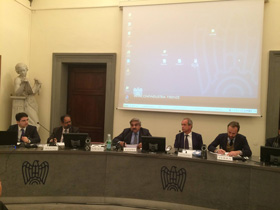
The Indian Ambassador to Italy, Anil Wadhwa (center), speaks to business leaders in Tuscany. (Photo: courtesy, Indian Embassy of Rome)
Eager to know more, I dropped in at the architecturally splendid Indian Embassy in Rome to meet with Ambassador Anil Wadhwa. Over cappuccino, he shared fascinating insights and details on the Indian presence in Italy. “No one knows how to make Indian tea here,” he joked.
“Italy is a country with whom India has had very deep commercial and economic ties,” he pointed out. “Between 2007 and 2012 Italy was the No. 1 one trade partner of India both in terms of investments as well as trade.”
In 2012, a chill set in between the two nations when two Italian marines were implicated in the killing of Indian fishermen in Indian territorial waters. Now, with the return of the marines to Italy to await trial, diplomatic ties have seen a revival. Recently, high level ministers from the Modi government were in Rome for the canonization of Mother Teresa, an occasion to restore the old cordiality.
“We have a roadmap for the future,” said Wadhwa. “The main focus is on the economic side—investments and cutting-edge science and technology, design, and we have traditional areas of cooperation which is in leather, textiles, gems, and jewelry. The embassy has organized about 12 focused commercial events in various Italian cities. Currently we are also talking about $3 billion in contracts and about joint manufacturing, too.”
Meet the first Indian historian
in Italy, and more—a diversity of profiles
The Indians who have
settled in Italy have very distinctive
stories about their
journey. While official numbers
are unavailable, the
Indian Embassy there estimates
the Indian population of Rome at about 25,000.
One of them is Sanjukta Das Gupta, who was earlier
teaching at Calcutta University in India. She moved
to Italy when she married an Italian colleague. She
now teaches at the Department of Oriental Studies at
La Sapienza University of Rome. She says that she is
the first Indian historian in Sapienza.
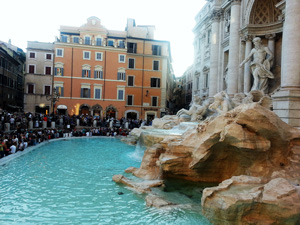
(Left) Trevi Fountain, Rome. (Photo: Lavina Melwani)
“The best part of Italy for me is that I live amid so much visible history,” she says. “Almost every road takes you to some site dating back to ancient times. But Rome is not only about the past, but the past blends in with the present. This for me is the greatest fascination of Italy.”
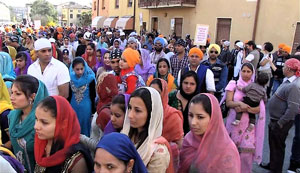
(Right) A gathering of Sikhs in Navaro. (Photo: Sikhi Sewa Society)
Ask her about the Indians in Italy and she divides them into several categories. There’s migrant labor—mainly from Punjab. They are spread mostly in the agricultural regions in the north, around Rome, in the Lazio region, and also down south in Naples, Bari, and Sicily. There are restaurant workers who are predominantly Punjabis, and religious migrants or priests and nuns, mainly from Kerala, who work in churches or with the Vatican.
Another set of Indians are those working in different UN organisations, the ‘international’ set, so to speak. Then there are the spouses—Indians married to Italians—and a floating population of students. She mentions that there are a few academics working in the management schools, in the ecumenical schools, and also some who are in the spacedesign industry.
According to statistics, the majority of the Indians are farmers from the Punjab, doing exactly what they did back home: farming. Almost 95 percent of the Indians here are in agriculture. Such is their significance to the cheese-making industry, that in a case study titled, “Indian Diversities in Italy,” by Kathryn Lum, for the European University Institute, she states that according to the leaders of the Coldiretti region, “without [the Punjabi migrant workers] the emblematic Italian cheese industry would be at risk.”
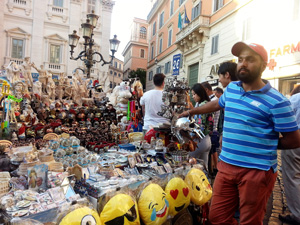
A Punjabi souvenir seller at the Trevi Fountain in Rome. (Photo: Lavina Melwani)
The South Asian presence is quite noticeable since Italy has taken in a large number of refugees. There are Bangladeshis boys selling everything from tourist trinkets to roses on the sidewalks, and there are many Pakistani tour guides. Indians are also a big part of the tourism industry. Be it at the Trevi Fountain or the Vatican, you cannot help noticing the Indians, Bangladeshis, and Pakistanis promoting tours and hawking souvenirs.
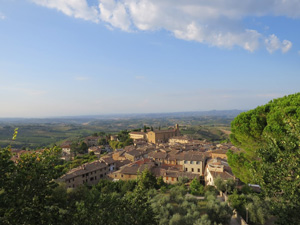
(Right) The Tuscan countryside. (Photo: Lavina Melwani)
Our 14-member group of family and friends stayed at Torre del Santos, a beautiful old villa in the village of Barberino Val d’Elsa at the edge of the hamlet of Petrognano, about a half-hour from the must-see cities of Siena and Florence. The Tuscan countryside is dotted with medieval villages, marketplaces, wineries, and restaurants. On my very first night I discovered that the Italian owner of the villa had been to India, and her teenage daughter is passionate about India and Indian food!
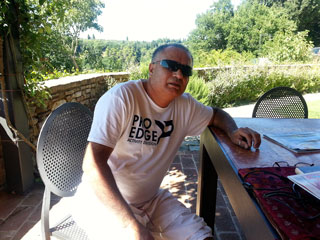
(Left) Balbir Singh Pabla works in the leather industry in Tuscany, and is also helping his local municipality in promoting tourism to the area. (Photo: Lavina Melwani)
Of the several Sikhs with whom I connected in Tuscany, one was Balbir Singh Pabla who worked with Italian leather goods designers. I learned a lot about how our Indian migrants function: he had brought his leatherworking skills and habits of hard work with him, had maintained his culture, family, and religion and yet had become a part of the Italian municipality and was helping to promote the local area to tourists.
Through our villa owner, I met Balbir Singh Sangha, who is an Italian chef with some of the best T-bone steaks in town! Sangha, who came from Hoshiarpur in the Punjab in 1989, came to Italy as a farmer. He had gone back home for an arranged marriage to Parmjeet Kaur, who is a housewife, and now has grown children in their 20’s. Gradually he got into cooking and for the past 20 years has worked in restaurants in Rome and Tuscany. He now cooks everything Italian—though at home it is always Indian food cooked by his wife.
The Hindu presence is apparent, too, in Italy, though much less than that of the Sikhs. Vishnu Kumar Soni, who deals in the export of scrap metal to India, is one of the devotees helping to build a Sanatan Dharma Mandir in Lavinio, in the municipality of Anzio. There are already two temples in Rome and there has been a good response to the building of this new temple, he says. “Hindus from different parts of Italy come together in Lavinio for jagrans, Krishna Janamashtami, Navratri, and a weeklong Diwali festival.”
The Indian Italian diaspora:
the big picture
Unlike the U.S., Italy is not a nation
of immigrants. Nor does it have the historic
ties with India that England does.
Not surprisingly, the size of the Indian
immigrant population in Italy is modest
compared to these two nations. According
to the Bureau of Labor Statistics,
there are over 150,000 Indians in Italy—
in contrast to the close to 4 million in the
U.S. A large majority of them, about 80%
by some estimates, are Punjabis.
Qualitatively, Indians in Italy can be seen as two distinct groups: the farmers in rural areas who are living in close-knit enclaves, virtually recreating India in Italy; and the professionals, diplomats, and academics who form a big part of the urban Indian-Italian population. The latter are forced to assimilate perhaps more so and faster than in America because of the lack of a massive number of Indians to congregate with and form groups with.
Not only is the Indian diaspora in Italy small, but it is also relatively nascent. Not surprisingly, Indians are not a visible force in politics, entertainment, business, academia, and other fields—the way they are in the U.S. and in England. In fact, small business entrepreneurship, the signature element of most Indian diaspora communities around the world, is largely absent here. A notable exception is a small number of restaurateurs who are starting to make their presence noticed.
An Indian ethos—cricket, gurudwaras,
and Kathak in the town square
The lack of numbers or clout hasn’t
stopped Indians from indulging, quite
visibly, in their culture and heritage.
Vishnu Kumar Soni came many years
ago as a tourist, liked it, and decided to
stay on in Anzio. He went back to India
to get married and brought his family
to Italy. He says, “The young Italians
are not into agriculture or construction,
but our people coming here are ready
to do any kind of work, and are already
comfortable in agricultural activities
from India.” As he points out, ‘Love-India’
(Lavinio) has 16 Indian and 11 Pakistani
spice stores because there are so
many South Asians there!
There are about 52 gurudwaras in Italy, and some local governments have also given land for stadiums to play cricket. There are also cultural festivals where groups perform on the beaches, and some shows from India. A Kathak performance by danseuse Shovana Narayan attracted a crowd of 1,200 in the town square.
Culture curry: Bollywood, yoga and
mixed marriages
Bollywood is also a spicy presence
in Italy. While eating in a wayside café
or shopping in stores, my attention was
often captured by a desi ad or programming
popping up occasionally on regular
Italian TV. In the past, Kabir Bedi, who
played the lead role in the hit TV series
Sandokan, was a popular celebrity. In recent
times, the actor was honored at the
River to River Indian Film Festival in Florence
where the Bollywood film Mohenjo-Daro, in which he also stars, premiered.
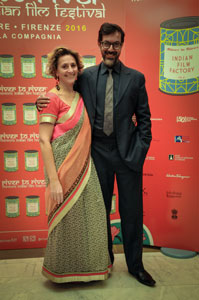
(Left) Indophile Selvaggia Velo is the founder of ‘River to River Indian Film Festival’ in Florence. She is seen here with actor and director Rajat Kapoor. (Photo: courtesy, Ambili Abraham)
The River to River Festival is now in its 16th year. I got in touch with Selvaggia Velo, who is the founder and driving force behind the festival. Why is she so passionate about this event? “Indian films hardly get a release in Italy, and the festival is one of the only places where you get to see such films. It all happened by chance. I liked India and cinema and decided to put the two things together; so with study and dedication, passion, intuition, and many other things, now we have just finished our 16th edition!”
Ambassador Wadhwa observed that a lot of Bollywood film shootings take place in Italy: “There’s a place called Matera, which is famous for Biblical films because the houses are in rock caves in the hillsides. It’s a very peculiar kind of setting—the whole town is made of stone, so it’s an ideal place for those kinds of films. But many Indian films have also been shot there.”
Ambili Abraham, an Indian dancer, has built her career on the Bollywood craze. She runs a dance school in Rome. Her father, who earlier worked in the Indian Embassy in Rome, is from Kerala, and her mother is from Mizoram. Abraham picked up dancing when she was five and for the past 16 years has been conducting classes and workshops all over Italy. The majority of her students are Italians, but also Indian children who have been adopted by Italian families and are in search of their roots. This year she worked with 140 students on a dance campus in Ancona, organized by La Luna Dance Center.
Abraham’s Bollymasala Dance Company has taught students who have now graduated and become teachers themselves! She has often been on Italian TV and is reputed to be the one who brought Bollywood dance to Italy. She says, “I have been blessed by students who really give me lots of love and respect. Italy is now my second home. My main aim is to make my students love the Indian cinematic world and make Italians understand the power of Indian cinema. After a month of dancing, they may say ‘I love Shah Rukh Khan!’ That does make a difference to me!” Abraham shared with me that an Indian-Italian couple has opened another Bollywood dance school in Rome now, called Bollywood Club.
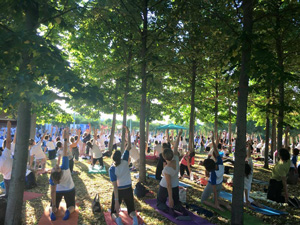
International Yoga Day at Auditorium Parco della Musica, a popular music complex in Rome. (Photo: Indian Embassy of Rome)
With so many Indians around, can mixed marriages be far behind? There are several Indian women marrying Italian men; more so than the other way around. Italian men often come back from India with an Indian wife. Roshni Sekhar came to Italy 30 years ago, after she married her husband Paolo Quircio, who was then working for Alitalia in Delhi. The couple have two children, Maitreya and Flaminia Bhavani, and have devoted themselves to propagating yoga in Italy. Sekhar, who is a direct disciple of Swami Vishnudevananda, noted follower of Swami Sivananda, runs the Centro Yoga Swami Vishnu and has also taught Hatha Yoga for the Sivananda Teachers Training Course in Italy.
She says, “We spread peace through yoga and we take demonstrations, theory classes, and practice classes to the high schools, to give a correct overall view of yoga to the young. Also, every year, through various cultural activities by raising funds, we support animal organizations in India and help in the support and cure of street animals.”
Yoga has indeed caught on in Italy. Says Sekhar, “Teaching in Italy was not easy when I started 25 years ago. In the beginning, most students would come for the physical benefits only. Now, a lot of people come for spiritual benefits, too. Also, Italy is the mystic heart of the West, and the Italian land has that sacred power, which India has.”
Samosas on the Tiber
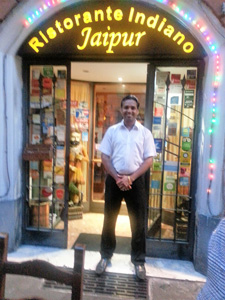
Indian restaurants have mushroomed all over Italy. There are several in the Termini Station area in Rome and in big cities like Florence and Milan. Yet, as Ambassador Wadhwa pointed out, while Indian food has caught on, there’s plenty of room for growth in the upscale category as most existing restaurants cater primarily to Indian group tours.
(Right) Mahendar Singh Chauhan, posing in front of Jaipur, his popular restaurant in the tourist district of Trastevere, near the Tiber River. (Photo: Lavina Melwani)
One of the popular restaurants is called Jaipur, in the tourist district of Trastevere, near the Tiber River. Come evening, the place springs to life with its many bars, cafes, and restaurants. Mahendar Singh Chauhan has run the restaurant with his brother and brother-in-law for 14 years. Since it was my last day in Rome, I still wanted to eat Italian food, but who can resist a plate of crisp samosas and chutney? Jaipur’s samosas were big and succulent, the décor opulent. On the night I visited the place, it was full of Indians. There was a grand buffet laid out and the air was redolent with the aromas of home.
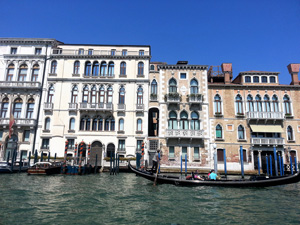
(Left) Gondoliers in Venice. (Photo: Lavina Melwani)
A natural affinity
Happily, the tourism trade between
the two countries is thriving. “I think the
Italians feel a natural affinity towards
Indians and vice versa,” says Wadhwa.
“They like the spirituality, they like the
people, they like the food, they like the
color, as far as India is concerned. And
Indians find Italian designs very fascinating.
The cities are very beautiful;
there is a lot of history and art here. Both
countries are actually rich in art and history,
so there’s a natural affinity.”
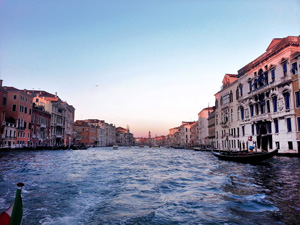
(Right) Venice, the floating city. (Photo: Lavina Melwani)
As he points out, the common factors are the beauty of the country, and the richness of a very ancient civilization: “It’s a very beautiful culture and there are very strong family-minded people here, very similar to what India has. That is something very unique in this country.”
I tried to get a feel of the real Italy by taking trains, buses, and trams wherever possible. I walked the streets wherever I could. We found our way around by asking for directions from Italians and desi strangers. When we were headed to the tourist hotspot of Trastevere, a talkative Bangladeshi street vendor guided us to the bus we should take. On the bus I met a friendly young Indian girl, the daughter of Sikh farmers. She had left the rural outreaches of Rome behind to live in the big city and study at university. She spoke fluent Italian and some English and one could see her future was right here, far from the mustard fields of the Punjab.
Lavina Melwani is a writer for several
international publications. She blogs at
www.lassiwithlavina.com.
Follow @lavinamelwani and
www.facebook.com/LassiwithLavina/
Enjoyed reading Khabar magazine? Subscribe to Khabar and get a full digital copy of this Indian-American community magazine.
blog comments powered by Disqus












